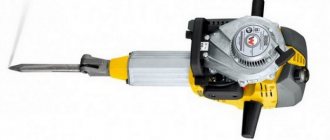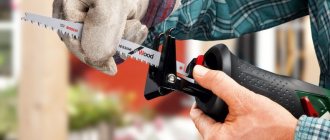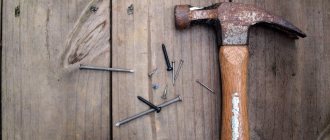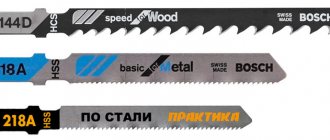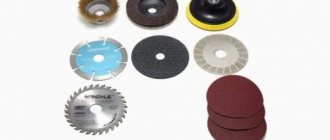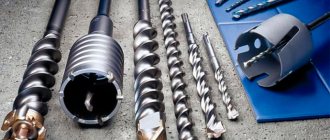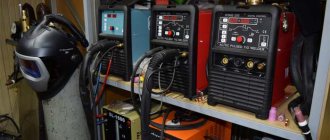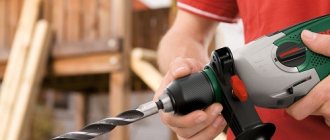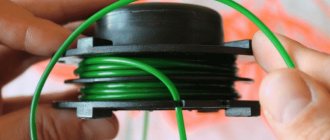Working principles of a jackhammer
A jackhammer is a tool that has a powerful impact force. Impact energy is the main characteristic of any such tool. It is considered the number of blows that are produced per minute, as well as the energy generated per minute. The device of a jackhammer is not complicated. The drive drives the firing pin, which is located inside the housing.
It sends mechanical impulses to the instrument’s performing organ – the pike, which makes rapid back-and-forth movements (about 1000-1500 beats per minute), and thereby destroys the necessary material.
Note! The energy released is very rough and the operator is subject to strong vibration and noise during operation, so all protective measures must be used.
Let's take a closer look at how an electric jackhammer works. The electric motor causes the rotor to move, which in turn moves the firing pin, which sends the mechanical movements of the dive. Despite the popularity of this type of tool, it has several disadvantages: due to the sparking of the electric motor, it cannot be used in rooms with an increased fire hazard. Disadvantages also include dependence on the power supply network.
What is most important when choosing?
The principle of operation of a jackhammer is clear; now you need to understand what role the lance and weight of the tool play when choosing. There are different types of peaks that are used for certain types of work. Let's look at them:
- Pike-crowbar - necessary for loosening the soil, dismantling concrete and brick structures, removing old road surfaces and working with rocks;
- Shovel - used for chipping ice and leveling the edge of asphalt;
- Z killed - necessary for cutting various materials.
The weight of the hammer also plays an important role. It determines which class the tool will belong to. They are divided into light, medium and heavy. Lightweight, weighing 5-6 kilograms, needed for finishing work and work at height. A medium hammer, weighing 5-10 kilograms, is used to work in a horizontal plane. A heavy hammer can weigh up to 30 kilograms and is used for foundation and soil work.
Important! Before choosing a jackhammer, you need to clearly determine the type of work that it will perform.
Electric jackhammer: choose for your needs
We talked about the jackhammer, how it works and its scope of application. Now it’s time to find out how to choose a jackhammer. There are several types of hammers: electric, pneumatic and gasoline. The disadvantages of an electric tool have already been mentioned above, but it also has a huge advantage - it is high power with low weight.
A pneumatic apparatus does not have the disadvantages of an electric one. They differ in turbine and volumetric. A volumetric tool works as a result of the expansion of compressed air in the pistons, and a turbine tool works through the action of air flows on the turbine. Volumetric devices are used to work in conditions of high humidity, and their disadvantage is the need to connect a compressor.
The gasoline hammer does not have many of the shortcomings of previous devices. Its main advantage is their independence from power sources. Disadvantages include carbon dioxide emissions and high fuel costs. In addition to the type of device, it is also necessary to take into account its power and the number of beats per minute.
Important! It is necessary to choose a tool with high-quality vibration protection and comfortable handles.
Dismantling work is of great importance in the construction industry. The main hand tool for performing them is a sledgehammer. For large-scale work, an automated mechanism is used, represented by a weight driven by a crane. There is an intermediate version of a mechanized device suitable for dismantling work of various sizes. This is a jackhammer.
Several parameters are used to classify the devices under consideration.
Based on performance, jackhammers are differentiated into three types.
- Lightweight options are designed for household work. They are capable of crushing plaster, tiles, etc., which makes them suitable for home repairs. The weight of such mini jackhammers is 5-6 kg.
- Medium power devices are suitable for asphalt, so they are used in some construction work. Weight from 6 to 10 kg provides the possibility of long-term horizontal holding.
- In industry and in the construction of buildings, high-power jackhammers weighing 15-30 kg are used.
However, mass is an indirect indicator of performance. There is a classification close to the above, based on other, more significant parameters. It also includes four types.
- The first includes jackhammers with impact energy up to 30 J and frequency up to 45 Hz. They are suitable for medium-strength materials such as asphalt, brick, clay, and work in confined spaces.
- The second type is represented by options with an impact energy of 40 J and a frequency of 34 Hz, used in general construction work.
- The third type includes models with impact energy up to 45 J and frequency up to 20 Hz. They are used for work with vertical impacts on durable materials.
- The fourth type is represented by hammers with an impact energy of more than 50 J and a frequency of up to 24 Hz. Such devices are used for high-strength materials.
Read also: Conditions for selecting circuit breakers
Based on the power source, there are four types of jackhammers.
- Pneumatic devices are the most common type. The power source for them is a compressor. The principle of operation is based on the pressure of compressed air molecules on the chisel. This equipment is suitable for destroying any structures made of brick and concrete. For household options, a power of 5 J is required, while for industrial models this parameter ranges from 10 to 100 J. This is enough to destroy asphalt, stone, concrete, etc.
- Electric hammers are powered from the mains. The principle of their operation is to drive the striker through the rotational element of the electric motor. Performance parameters are up to 1700 W of power, 45 J of impact energy and 2000 beats per minute of frequency. Thus, these types of jackhammers have high impact power, but are not suitable for cutting and drilling materials.
- Gasoline devices are driven by an internal combustion engine, which does not have valves and a shaft. With low power, the main advantage of these options is autonomy, that is, the ability to be used anywhere. This is due to the absence of the need to connect to an energy source. The duration of operation is determined only by the amount of fuel. In addition, jackhammers of this type are considered safer in comparison with analogues. However, they have a high noise level. These models are used in the mining industry for the destruction of concrete, asphalt, and frozen soil.
- Hydraulic hammers use a variety of power sources. They are usually used in emergency rescue operations.
Pneumatic hammers are also divided into two types based on their operating principle.
- Volumetric devices are driven by rapidly expanding air in the chamber.
- The operation of turbine options is ensured by the energy generated by the rotation of the turbine.
The simplest classification of jackhammers based on a set of basic parameters differentiates them into professional and household.
It should be noted that there are tools similar in design and purpose to jackhammers.
Concrete breakers are distinguished by their large size, weight and productivity. These devices are designed for vertical and inclined work with concrete slabs, rocks, asphalt pavement, and frozen soils. Rotary hammers are usually more compact than jackhammers or similar in size, they are distinguished by greater accuracy and the ability to perform the functions of a drill and screwdriver with adjustable speed and reverse. This versatility makes them much better suited for household work. Thus, the operating instructions for PE-2520M indicate the possibility of its use as both a jackhammer and a drill.
Design and principle of operation
A jackhammer works on a very simple principle:
- the motor transmits force to the firing pin located inside the housing;
- from the striker the impulse passes to the chisel;
- the impact part, under the influence of the received impulse, can oscillate at a speed of up to 25 beats per second.
This interaction between the components of the hammer allows you to quickly break various materials.
Impact hammers quickly replaced heavy hand hammers, suspended weights, and explosives. As it turns out, they are very productive and allow you to work much more efficiently. By using a jackhammer, you can work not only faster, but also with the highest possible quality: you can save individual blocks for later use. It is not without reason that such a tool is used not only by professional, but also by amateur builders.
By weight
The wide range of applications of jackhammers is achieved due to the specific differences between individual models. Thus, the lightest devices (whose weight is less than 6 kg) are used mainly for domestic purposes. They can confidently cope with crushing tiles, plaster, and relatively thin cement floors. Medium-weight devices are widely in demand among builders; they are used to break asphalt. The most powerful devices weigh up to 30 kg and are needed mainly in large-scale construction work.
Read also: How a triac power regulator works
By drive type
Pneumatic jackhammers are used more often than other options. Compressed air is obtained using a compressor. Under the influence of the air flow, the chisel begins to move. Household air-driven devices must deliver impacts with a force of at least 5 J. For industrial units, the requirements are twice as high. Such characteristics make it possible to:
- destroy sidewalks;
- demolish buildings made of natural or artificial stone;
- break through concrete and so on.
Hammers with an electric motor are equipped with special internal strikers. The strikers are driven by rotating parts. Electrically driven units can easily break a wall or covering. But it is important to understand that the high power generated by an electric motor is not always good. This property makes it difficult to fully drill and cut materials. Problems may also be associated with the appearance of sparks. They are found even in the most reliable models. As a result of this feature, electrical devices cannot be used in places with high fire risks. Conventional models are not able to work separately from the mains. An exception may be battery versions, however, they are heavier than their plug-in counterparts.
Hourly current consumption (in terms of continuous operation) reaches 1.7 kW. Each blow has a force of 45 J, and such blows are delivered 2000 times per minute. Important: all modern models of fenders with an electric motor are equipped with double insulation, so you can connect the device to a home outlet without any fear. A gasoline (also known as a petrol jack) hammer is easy to use. Such mechanisms can work even where there is no electricity and it is not very convenient to use compressors. In addition, versions with internal combustion engines are safer than electric or pneumatic deflector systems. But we must take into account that the heat engine creates a lot of noise. You will also have to constantly fill the tank with fuel, which means continuity of operation is a big question.
Petroleum hammers driven by gasoline engines perform well:
- during the destruction of rocky and icy soil;
- when dismantling asphalt and concrete;
- in the process of resource extraction.
Impact breakers with internal combustion engines help to break up materials of varying hardness in a short time. The size of the processed blocks does not play a special role. Hydraulic devices deservedly stand out in a separate group. The drives for them are a variety of devices. Basically, the hydraulic fender, due to its versatility and high performance, is used by rescue teams.
Device
The main structural elements for any type of jackhammer are represented by a striker, a nozzle, a cartridge, etc.
Pneumatic piston models are designed according to piston systems based on the impact principle. The main structural elements are represented by a starting spool, a striker, a piston, a fitting for a compressor hose, a cup with a ring valve and a valve box, and a muffler. In addition, jackhammers include two springs, a shock absorber, a retaining ring, a handle, and a body.
These parts are combined into several units.
- The hammer, also called the trigger and air distribution mechanism, includes the firing pin and the barrel.
- The vibration protection of the handle is represented by a glass and sealing bushings.
- Anti-vibration protection from the chisel includes a manipulator and a spring-loaded bushing.
- The housing-handle includes a housing, an aerodynamic noise muffler and a trigger mechanism.
The impact system has two main functions: supply, distribution and removal of air, converting its energy into work.
Electric models are equipped with such specific components as an electric motor, a gearbox that serves to convert the rotation of the latter shaft into reciprocating movement, a crank mechanism with a piston that provides pressure in the cylinder acting on the firing pin.
Components specific to internal combustion engine jackhammers include the carburetor, fuel tank, starter, ignition system, and fuel pump. In addition, taking into account the increased vibration of these devices, the handle and control elements are separated from the body by a spring suspension.
There are several options for attachments for various purposes. Thus, a chisel is used to destroy concrete and metal; scrap or cylinder - brick, concrete, ice; pencil or pick - asphalt, brick, frozen soil; shovel – asphalt, ice; tamper – for soil compaction.
In addition, there is additional equipment for a hammer. It includes the following four devices. An automatic speed controller, called soft start and idle speed limiter, serves to extend engine life by eliminating overloads and gradually accelerating. The principle of its operation is based on adjusting the speed in accordance with the load. The side handle improves ease of use by promoting proper grip and distribution of effort. The impact frequency control increases the degree of control of the tool, allowing the demolition hammer to be adjusted to suit materials of varying hardness. The button lock ensures that there is no need to constantly hold it during operation.
The principle of operation of jackhammers is to create reciprocating movements of the striker located in the barrel, which is not kinematically connected with other parts. This is accomplished by different mechanisms depending on the type of hammer.
Thus, in piston pneumatic models, the air supplied by a hose from the compressor overcomes the resistance of the valve spring when acting on the handle. As a result, the valve moves, opening the opening of the impact mechanism. Alternately, a vacuum and excess pressure are created in the lower and upper parts of the cylinder due to the passage of compressed air between them by the valve system, generating reciprocating movements of the striker.
The operation of a pneumatic turbine hammer is based on the drive by the energy generated by the rotating air of the turbine wheel.
Gasoline hammers are also usually equipped with a pneumatic impact mechanism. The piston, changing the pressure in the cylinder, leads to the movement of the hammer piston with an attached tip.
Choice
First of all, it should be noted that jackhammers are primarily professional equipment. This is due to their lack of demand for domestic and economic purposes, as well as their high cost.
Consequently, the main factor in choosing a jackhammer is the purpose, that is, the volume and nature of the planned work. This determines the required parameters and functions of the device. In addition, it is not advisable to purchase such a device for one-time work.
There are several basic parameters for jackhammers.
- Weight determines the ability of the device to be supported by weight. Thus, models weighing up to 6 kg are relevant for high-altitude work or cramped conditions. Hammers up to 10 kg can be held horizontally when carrying out horizontal work on dismantling walls and making holes. With heavier hammers you can work vertically on foundations, soil, etc.
- The impact force is equivalent to the amount of material it breaks off. Thus, the effectiveness of the tool and the speed of work directly depend on this indicator. It can range from 2.8 to 63 J.
- The impact frequency, reflecting their number per unit time, also determines the speed of work, but is inversely related to the previous parameter. That is, as the force of impacts increases, their frequency decreases. So, for light models this characteristic can be up to 3500, while for heavy models it can be from 1100.
- Power determines the breaking power of a jackhammer and the operating cycle time. It is 0.5–2 kW. For finishing work, 1.2 kW is sufficient. To destroy a concrete or brick wall, 1.6 kW is needed. The greatest power is required for dismantling road surfaces.
Read also: How to properly bleed a bottle jack
The given technical characteristics of jackhammers are largely determined by the type of drive. That is, one of the classifications is of great importance. To understand how to choose a model, you need to know the features of the types allocated to it.
Pneumatic devices, in comparison with electric and internal combustion engine hammers, due to their simpler design, are considered more reliable and durable at a significantly lower cost. In addition, they have the smallest weight, ranging from 1.5 to 16 kg. In addition, such hammers are very productive. Finally, these models are suitable for work in conditions of high humidity and near flammable substances. The main disadvantage is that it is tied to a power source in the form of a compressor, which will have to be purchased separately at a considerable price. Moreover, it is necessary to select this device based on the parameters of the hammer. The main characteristics are volume and working pressure. The compressor parameters determine the duration of operation.
Electric jackhammers are tied to a power source, just like pneumatic jackhammers. In contrast, such devices cannot be used near flammable substances due to the sparking of the motor during operation. They are also not suitable for high humidity conditions. Despite this, they are a very common type of jackhammer. This is due, first of all, to significantly greater efficiency in comparison with pneumatic demolition hammers and models with internal combustion engines. In addition, they have the best environmental performance, the lowest level of vibration and noise. Despite the external energy source, it is not represented by additional equipment, provides unlimited operating time and ease of connection. Finally, with a more complex design, they are easy to maintain. In addition to the main parameters, engine power is of great importance for these hammer models. For domestic purposes, jackhammers of this type are most often used.
In addition, there are battery options that combine the above positive qualities of electric hammers with the autonomy of gasoline ones. However, they are not so mobile, since the duration of operation is determined by the capacity of the battery, which requires further charging.
Models with internal combustion engines are the most mobile. At the same time, they are characterized by high noise levels and the presence of toxic emissions. In addition, instead of being tied to an energy source, they require a supply of fuel, the amount of which determines the duration of operation. Finally, ICE hammers are the most difficult to maintain: they require draining residual fuel, cleaning filters, etc.
In addition, the preferred working position of the jackhammer is of great importance.
Horizontal modifications are distinguished by their low weight and the presence of appropriate handles: rear holding and front control.
Vertical jackhammers are heavier and have side handles.
Finally, the manufacturer plays a significant role when choosing. There are a number of brands known for high quality products. Manufacturers that produce the best jackhammers include Bosch, Sparky, AEG, Makita, DeWALT, Hitachi, Metabo, Milwaukee.
Subtleties of choice
But not only the geometry of the jackhammer and the type of its drive are important - each type of attachment determines the possibility of performing certain specific jobs. Thus, “crowbar” peaks are designed to:
- loosen the soil;
- demolish brick and concrete walls;
- dismantle old road surfaces;
- process minerals, rock stone.
A shovel is needed if you need to level asphalt edges and also chip away ice. Chisels can be used to cut a wide range of materials. Accordingly, the functionality of a jackhammer directly depends on compatibility with certain attachments. The mass of a particular bumper also deserves a separate discussion. Thus, a tool weighing up to 6 kg is chosen if you plan to work at heights, and the heaviest ones (30 kg and above) allow you to work with soil and break old foundations.
As already mentioned, only pneumatic hammers can be used in fire hazardous environments. However, when choosing them, the characteristics of the hose are critical. The connecting diameter is not suitable, which means it will not work. The same thing will happen if there is not enough length. Of course, they also take into account:
- type of material;
- wall thickness;
- diameter and internal section;
- permissible pressure level.
A pneumatic device that delivers impacts with a force of 30 J can successfully operate on weight, as well as in confined spaces. If it is not clear in advance what specific work needs to be done, you need to take universal equipment. It delivers impacts of 40 J. But for concrete, natural stone and other very hard materials, chippers with an impact energy of 50 J or more are recommended. We must not forget about whether it is comfortable to hold the tool in your hands - very powerful devices are often heavy.
The weight limitation is significant for pneumatic, electric, and gasoline systems. In the last two cases, experts recommend taking into account the engine power. The weight of the device should be maximum if you plan to break the old floor or perform other complex work. But for treating walls and other vertical surfaces, you should take something lighter.
As always, you need to pay attention to the manufacturer’s brand and take into account its reputation. Some companies that make jackhammers produce high-quality products. But there are also those that supply downright bad products. Important: conscientious manufacturers are not only among the leaders of the global and domestic markets. It is not advisable to buy electrical devices that are not equipped with a button lock: you will have to constantly hold the start switch manually.
Devices with idle speed limits work much longer and are more efficient. This limitation is extremely simple to implement. As soon as the sensor detects a drop in load intensity, the engine speed drops on command. But as soon as the load increases, the revolutions become higher. The vibration damping complex is of great benefit. If it is not provided for by the designers, it will be more difficult for operators, and there will also be a significant health risk.
Read also: How to set the sharpening angle of a knife on a sharpener
Finally, for a more accurate and competent choice, it is useful to analyze the characteristics of individual brands of jackhammers. Fenders from the Japanese corporation Makita deservedly have a very good reputation. This company has been supplying power tools for over 100 years. You can remove and install attachments on Japanese brand bumpers quickly and completely safely. The developers have provided built-in units that regulate the number of revolutions per minute.
Good results are also achieved using Bosch jackhammers. The German concern values its reputation and carefully monitors the quality of its finished products. What is important is that the packaging is marked with a list of basic characteristics - choosing the most suitable modification is not difficult. You can also consider fenders from Hitachi, Zubr, DeWalt and other domestic and foreign manufacturers that have proven themselves.
Application, operation
The main areas of use for jackhammers include construction and mining.
In the first case, they are used to dismantle structures during redevelopment and demolition, cutting metal, removing concrete and asphalt road surfaces, compacting soil in hard-to-reach places, constructing wells, loosening frozen soils, making holes and niches, and removing ice.
In the mining industry, jackhammers are used when more powerful equipment is not available. Thus, the conditions of use in mines, which primarily consist of limited space, determine the need for tools of compact sizes. In addition, workings are processed along the entire radius. Therefore, a lightweight hammer is required that can be used upside down.
The scope of application is largely determined by the type of device: in what conditions and in what atmosphere to work, etc.
Some features of the operation of jackhammers were noted above. Regardless of the type of device, there are general rules. Firstly, before starting work, you should lubricate the tip of the nozzle with any plastic lubricant such as lithol and grease. Secondly, it is recommended to add lubricant to the tool barrel when working at least twice a shift in order to extend its service life. In this case, use various oils for the jackhammer in accordance with the instructions. Some recommend I20A, others recommend 15W-40 gear oil, etc. Thirdly, you should prevent dirt and water from getting into the device, rinse the lubricant cartridge with gasoline after completion of work, having first removed the nozzle. Fourthly, it is necessary to follow the instructions, using the hammer-breaker for its intended purpose and without overload. Fifthly, it is recommended to carry out maintenance once a month, which includes complete disassembly and washing of all parts with gasoline or kerosene.
In addition, there are specific operating features for each type of jackhammer.
Thus, after a long break, before starting work, it is recommended to disassemble a pneumatic hammer and wash it thoroughly with gasoline. Then, for two weeks, the barrel should be lubricated with pneumatic oil 3 to 4 times per shift.
For electric models, timely replacement of brushes is necessary. In addition, technological breaks of 10–15 minutes should be taken at intervals of 25 minutes to avoid overload.
On gasoline jackhammers, it is necessary to first prepare a fuel mixture, including gasoline and oil, of a certain concentration. The instructions indicate what kind of oil to pour into the jackhammer, in what quantity, etc. Moreover, it is necessary to completely exhaust the fuel mixture or drain the remainder. This avoids contamination of the battery with an oil film.
Each type of device under consideration is characterized by specific faults.
On pneumatic versions, the channels most often become clogged. This can be solved by detailed washing with kerosene. They may become clogged with ice, which occurs when the temperature at the compressed air outlet drops sharply. This is eliminated by thawing.
The main cause of breakdowns of electric jackhammers is a violation of the electrical circuit, which consists in the breakdown of the button and the erasure of the brushes transmitting electricity to the motor. Replacing brushes is very simple. Repairing the button is more complicated due to the fact that in many cases it is necessary to disassemble the entire case, however, on modern models, taking into account this feature, it is equipped with a separate cover to simplify replacement.
For models with internal combustion engines, carburetor clogging is typical. Finally, on any jackhammer, jamming of the nozzle in the chuck occurs. In this case, dismantle the cartridge and squeeze out the nozzle, after which the cartridge is washed from lubricant with kerosene.
If you find an error, please select a piece of text and press Ctrl+Enter.
Tips for use
When working with jackhammers, it is necessary to use crowns of greater strength, the harder the material being processed. When asphalt or granite is processed, wide crowns are used. But the penetration is strictly limited, otherwise there is a great danger that the tool will become blocked. If this does happen, the hammer will have to be rocked - then it can be removed quickly and easily. Drilling concrete of durable grades can only be done with chippers with special peaks. The extended working surface of these nozzles makes it easier to separate layers of material. For crushing rock or asphalt, a T-shaped handle is preferred. But if you are working at an angle to the surface, it is recommended to use D-shaped holders.
Lubricant should be poured into a newly purchased bumper three or four times during a shift, until 2 weeks of operation have passed. Then you will have to add oil twice during a standard shift. Attention: the hammer should not bounce when working. If this happens, something is clearly being done incorrectly. Oil is usually added through a lubrication nozzle, or if it is not available, a nipple is used.
It must be remembered that fenders almost always break due to excessive loads and improper use. Therefore, their power must always correspond to the complexity of the work performed. Continuously hammering a wall, asphalt, etc. should not take more than 25 minutes. After this there is a pause of at least 10 minutes. Before loading the lance into the striker, it is necessary to lubricate the shanks with grease.
To learn how to use a jackhammer correctly, watch the following video.
It is impossible to imagine construction, major or minor repairs, without first dismantling the surfaces, and of course, an indispensable tool here is a pneumatic jackhammer. The scope of activity in which this tool is used is not limited to this, it is quite wide. Pneumatic impact bumpers are widely used in various types of production, in various industries, including mining, road construction, road repair work, and in places where preliminary destruction of structures and coatings is required.
